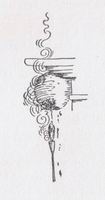|
1999-2004 (Return to Web Text-ures) |
Click Here to return to |
|
1999-2004 (Return to Web Text-ures) |
Click Here to return to |
ENEMIES
WASPS, like other folk, have their enemies.
Certain birds catch and eat them, and certain badgers, it is said, feed upon their nests.
One would not expect them to fall victims to such a foe as the ant, yet such is the case in tropical countries.
Mr. Belt, in his “Naturalist in Nicaragua,” tells this remarkable story, --
“The ants send off exploring parties up the trees, which hunt for nests of wasps, bees, and probably birds. If they find any they soon communicate the intelligence to the army below, and a column is sent up immediately to take possession of the prize. I have seen them pulling out the larvae and pupae from the cells of a large wasp's nest, whilst the wasps hovered about, powerless, before the multitude of invaders, to render any protection to their young.”
The worst enemies of the wasps are to be found within their own nests, from parasites of their own Order.
Certain little chrysis flies are bred in the nests at the expense of the wasps.
The bold mother chrysis enters the nest, deposits her own egg in the cell with a wasp larva, and when the chrysis hatches it proceeds to suck the juices of its host. As the chrysis lives and commits its depredations at the bottom of the cell below the wasp larva; it is not discovered.
Perhaps the nurse wasps wonder why some of their little charges are so sickly, but there is reason enough, for their life juices are being drained, and when they have finally spun their cocoons they are wholly at the mercy of the enemy and dwindle to a small shrunken mass, while the young chrysis, fat and hearty, finally makes its own cocoon beneath the defrauded wasp larva, first forming a sort of roof over its end of the cell. This roof is light brown in colour and looks not unlike the scale of a pine-cone seed.
If the roof is carefully broken away, the young usurper will be discovered wrapped in a glistening silvery blanket, a royal covering compared to the simple silken covering of the young Vespa.
There is nothing in its line, prettier than the little tinsel cocoon one can pull out of the raided cell, and within which lies the infant chrysis. It is a little savage wrapped in robes of savage splendour.
Its transformations completed, young chrysis finds its way out through its own roof and through the tough cocoon built by the despoiled larva, a small impertinent-looking black fly with long sensitive antennae.
There are several other parasites, vegetable as well as animal, that infest the Vespae; so, in spite of her formidable weapon, Madam the Wasp cannot free herself from all enemies. The toad is said to find the wasp an agreeable article of diet, and to swallow the piquant delicacy with relish. This finished gourmet has been seen sitting close to a wasp's nest and snapping up the delicious morsels as they drew near, winking his eyes in evident enjoyment of the fiery repast.
Boys are the natural foes of the wasps, destroying their nests for the mere fun of it, but the Creoles of Mauritius take the nest for the sake of the larvae, which they roast in the combs and eat.
The nests are taken by burning out the wasps, and the combs are sold at the bazaar of Port Louis.
Destroying wasps' nests by burning is a common practice to-day, as it was at the time of Euripides, who thus refers to it in his drama “The Cyclops”: --
Chorus of Satyrs (to Ulysses, who tells them they must help him to put out the Cyclop's eye with an enormous burning-brand). “How lightly would 1 lift the load of e'en a hundred wains, if that will help us grub out the eye of the doomed Cyclops, like a wasp's nest.”
